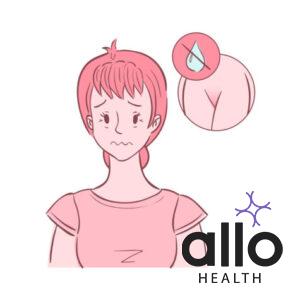What Is Blue Waffle Disease and How Can It Be Treated?

Allo Health is dedicated to personalized well-being, offering support and trusted information tailored to individual health goals. The platform emphasizes human-generated content, led by a distinguished medical team of experts, including physicians and sexual health specialists. Their commitment to credibility involves rigorous fact-checking, authoritative research, and continuous updates to ensure accurate, up-to-date information. Allo Health's unique approach goes beyond conventional platforms, providing expert-led insights and a continuous commitment to excellence, with user feedback playing a crucial role in shaping the platform's authoritative voice.

Dr. Raj. R holds an undergraduate medical degree from the Philippines, and has a bachelors background in Psychology. His experience working in the field of urology further brought his interest forward in working towards his passion of understanding the science of attraction, intimacy, sex and relationships. A key motto he practices by remains unprejudiced and non-judgemental care.
Why This Was Upated?
Our experts continually monitor the health and wellness space, and we update our articles when new information became available.
Updated on 12 April, 2024
- Article was updated as part of our commitment to diversity, equity, and inclusion.

"The following blog article provides general information and insights on various topics. However, it is important to note that the information presented is not intended as professional advice in any specific field or area. The content of this blog is for general educational and informational purposes only.
Book consultation
The content should not be interpreted as endorsement, recommendation, or guarantee of any product, service, or information mentioned. Readers are solely responsible for the decisions and actions they take based on the information provided in this blog. It is essential to exercise individual judgment, critical thinking, and personal responsibility when applying or implementing any information or suggestions discussed in the blog."
So, you might have come across some rumors or stories about this mysterious-sounding “Blue Waffle Disease” on the internet. But let’s set the record straight! Blue waffle is not a real medical condition or a recognized disease. It’s an internet hoax that has been circulating for quite some time. So, don’t panic or get too curious about it. Instead, let’s focus on real health topics; remember, it’s always best to rely on credible sources for accurate information! Stay informed, and stay safe!
What Is Blue Waffle Disease? Is It Real?

Blue waffle disease is a fictional and fabricated internet hoax that claims to be a sexually transmitted infection (STI) affecting women. It’s often described as a severe and sexually transmitted infection that causes the vulva to turn blue and appear swollen, hence the name “blue waffle.” The term is generally used to indicate a blue vagina caused due to irritation and inflammation of sexually transmitted infections. But there is no blue vagina! No infection can turn a vagina blue.
The term “blue waffle” is not recognized in the medical community and is not a legitimate diagnosis or medical condition.
The blue-waffle hoaxers included some real symptoms of the vagina to make up the term blue-waffle disease. These symptoms include itching in the vagina, discoloured vulva and abnormal discharge from the vagina.
Blue Waffle Disease” as it is not a recognized medical condition.
“Blue Waffle” is an internet urban legend and a term used to describe a fictional, highly exaggerated and sexually transmitted infection (real STI) that primarily affects women.
Does Blue Waffle Disease Exist?
No, “Blue Waffle Disease” does not exist as a real medical condition. It is a fictitious and fabricated internet hoax that originated as a shock-value rumour on the internet.
Rigorous or rough sex can potentially cause cuts and tears in the vagina. The vagina is a sensitive and delicate area, and during sexual activity, especially with aggressive or forceful movements, there is a risk of causing injuries to the vaginal tissues.
The fictional blue waffle disease symptoms are similar to some real vaginal infections. These common symptoms include-
- Unusual discharge from vagina
- Smelly discharge
- Burning sensation in the vagina
- Swelling around the vagina
- Pain during sex
- Vaginal dryness
Understanding the Origins of Blue Waffle Disease
Blue waffle disease, also called blue waffle vaginitis, is a term used to describe an infection or inflammation of the vagina.
Although the term has been around since the 2000s, it is not recognized by the medical community as a real condition.
Many health experts believe that the term and the related images circulated on the internet are fake, misleading, or the result of a cruel trolling campaign. Some doctors suggest that it may be a combination of various vaginal infections, or photographs of vaginas with unusual bruising, swelling, or discoloration.
Despite the lack of medical evidence supporting the existence of blue waffle disease, the term has gained significant attention on the internet and social media. Some people have even claimed to have contracted the disease, leading to widespread panic and confusion. Any unusual symptoms or changes in vaginal health should be evaluated by a medical professional, rather than relying on internet rumors or self-diagnosis.
In addition, the spread of false information about blue waffle disease can have serious consequences, including stigmatizing and shaming individuals with vaginal health issues. It is crucial to prioritize accurate and reliable sources of information when it comes to health and wellness, and to avoid spreading rumors or misinformation that can harm others.
Symptoms of Blue Waffle Disease

At present, there is no clear and consistent set of symptoms that can be linked to blue waffle disease. Depending on the source, the symptoms of this condition can vary widely. Some of the alleged symptoms associated with blue waffle disease include:
- Pain or discomfort in the vaginal area
- Burning or itching sensations
- Abnormal or foul-smelling vaginal discharge
- Swelling or redness of the labia or vulva
- A blue or green discoloration of the vaginal area
- Blisters, sores, or lesions on the vaginal area or surrounding skin
- Fever or unexpected weight loss
Many of these symptoms can also be indicative of other infections or conditions, such as a yeast infection, bacterial vaginosis, or a sexually transmitted disease like chlamydia or gonorrhea. Therefore, if you experience any of these symptoms, it’s essential to seek medical attention promptly.
How Blue Waffle Disease Is Diagnosed
Since blue waffle disease is not a recognized medical condition, there are no official diagnostic criteria for it. If you experience symptoms that suggest a vaginal infection or inflammation, it’s crucial to see a healthcare professional for an accurate diagnosis and treatment. Typically, a healthcare provider will conduct a physical examination, take a medical history, and perform laboratory tests to determine the cause of your symptoms. This may involve taking a vaginal swab sample, a urine test, or a blood test.
What Are the STIs With Similar Symptoms to Blue Waffle Disease?
Blue waffle disease is not a medically recognized condition. In fact, the term “blue waffle” is often used as a slang term to describe a fictional sexually transmitted infection. Despite this, it’s still crucial to take any symptoms you experience seriously and seek medical attention if necessary. Instead of focusing on “Blue Waffle Disease,” let’s discuss some common STIs that can cause symptoms in the genital area:
- Chlamydia: Chlamydia is a common bacterial STI that can affect both men and women. It often presents with symptoms like abnormal vaginal discharge, pain or burning during urination, and pain or swelling in the testicles for men. However, many infected individuals may not show any symptoms.
- Gonorrhea: Gonorrhea is another bacterial STI that can cause similar symptoms to chlamydia, such as painful urination, abnormal discharge, and pelvic pain for women.
- Genital Herpes: Genital herpes is a viral STI caused by the herpes simplex virus (HSV). It can cause painful sores or blisters in the genital or anal area and is highly contagious.
- Syphilis: Syphilis is a bacterial STI that can progress through several stages, each with its own set of symptoms. It often starts with painless sores (chancre) at the site of infection and can progress to a rash, fever, and other systemic symptoms if left untreated.
- Trichomoniasis: Trichomoniasis is a parasitic STI caused by the parasite Trichomonas vaginalis. It can cause symptoms such as vaginal itching, abnormal discharge, and discomfort during sex or urination.
Prevention and Risk Factors for Blue Waffle Disease
Due to the lack of clear diagnostic criteria and credible information about blue waffle disease, it’s challenging to provide precise prevention guidelines or identify specific risk factors for this condition. However, like other vaginal infections and STDs, the general advice to minimize the risk of blue waffle disease includes practicing safe sex, maintaining good personal hygiene, avoiding intimate contact with infected individuals, and regularly monitoring your sexual health through routine screening.
Additionally, practicing safe sex can help reduce your risk of contracting sexually transmitted infections, including those that may cause symptoms similar to those associated with blue waffle disease. Using condoms during sexual activity and getting regular STI screenings can help protect your sexual health.
Treatments for Blue Waffle Disease: Medications and Procedures
Since there is no standard treatment for blue waffle disease, the best approach will depend on what caused the symptoms. Treatments may include medication or procedures to address the underlying infection or inflammation. This may involve antibiotics, antifungal medications, or antiviral drugs to target the specific pathogen causing the symptoms. Additionally, you may need to use topical creams, gels, or suppositories to reduce inflammation and soothe the affected area.
In some cases, surgery may be necessary to remove damaged tissue or to repair any structural abnormalities that may be contributing to the symptoms. It is important to seek medical attention as soon as possible if you suspect you may have blue waffle disease, as early diagnosis and treatment can help prevent complications and improve outcomes.
Conclusion:
While there is no scientific evidence to support the effectiveness of alternative therapies for blue waffle disease, some people may find them helpful in managing their symptoms or promoting overall wellbeing. Some alternative therapies that may be beneficial include natural remedies, like herbal teas, botanical extracts, or aromatherapy, or holistic treatments, such as acupuncture, massage, or meditation. However, before trying any alternative therapies, it’s essential to consult with a healthcare professional to ensure they are safe, appropriate, and effective for your individual needs.
It’s important to note that spreading false information about medical conditions can be misleading and potentially harmful. It’s always advisable to rely on accurate and verified sources of information when it comes to your health.
Frequently Asked Questions:
Q. Is Blue Waffle Disease a Real Medical Condition?
A. No, Blue Waffle Disease is not a real medical condition. It is a fake STI. It is an internet hoax and a fabricated concept with no scientific basis. The images associated with it are often misleading and not representative of any medical condition.
Q. What Are the Symptoms of Blue Waffle Disease?
A. Since Blue Waffle Disease is a fictional creation, there are no specific symptoms attributed to it. The so-called symptoms and images circulating online are misleading and may cause unnecessary fear and anxiety. It is essential to rely on credible sources for health information and consult a healthcare professional for any health concerns.
Q. Is There Any Risk of Contracting Blue Waffle Disease?
A. As Blue Waffle Disease does not exist, there is no risk of contracting it. However, it is crucial to be aware of real sexually transmitted infections (STIs) and practice safe sex to protect against health risks. Using barrier methods like condoms and regular STI screenings are essential for maintaining sexual health.






































